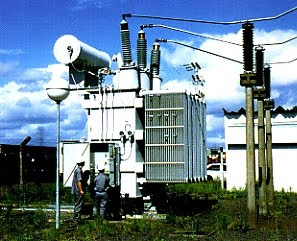
While power line electrical transformers are commonly recognized, there are other various types and sizes as well. They range from huge, multi-ton units like those at power plants, to intermediate, such as the type used on electric poles, and others can be quite small. Those used in equipment or appliances in your home or place of business are smaller electrical transformers and there are also tiny ones used in items like microphones and other electronics.
Probably the most common and perhaps the most necessary use of various electrical transformers is the transportation of electricity from power plants to homes and businesses. Because power often has to travel long distances, it is transformed first into a more manageable state. It is then transformed again and again, or “stepped down,” repeatedly as it gets closer to its destination.
When the power leaves the plant, it is usually of high voltage. When it reaches the substation the voltage is lowered. When it reaches a smaller transformer, the type found on top of electric poles, it is stepped down again. It is a continuous process, which repeats until the power is at a usable level.
You have likely seen the type of electrical transformers that sit on top of electric poles. These, like most electrical transformers, contain coils or “windings” that are wrapped around a core. The power travels through the coils. The more coils, the higher the voltage. On the other hand, fewer coils mean lower voltage.
Electrical transformers have changed industry. Electric power distribution is now more efficient than ever. Transformers have made it possible to transfer power near and far, in a timely, efficient, and more economical manner. Since many people do not wish to live in close proximity to a power plant, there is the added benefit of making it possible for homes and businesses that are quite a distance from power plants to obtain dependable, affordable electricity. Much of the electricity used today will have passed through many electrical transformers before it reaches users.
Electrical transformers are used to "transform" voltage from one level to another, usually from a higher voltage to a lower voltage. They do this by applying the principle of magnetic induction between coils to convert voltage and/or current levels.

Electrical transformers are used to "transform" voltage from one level to another, usually from a higher voltage to a lower voltage. They do this by applying the principle of magnetic induction between coils to convert voltage and/or current levels.
Electrical transformers can be configured as either a single-phase or a three-phase configuration. There are several important specifications to specify when searching for electrical transformers. These include: maximum secondary voltage rating, maximum secondary current rating, maximum power rating, and output type. An electrical transformer may provide more than one secondary voltage value. The Rated Power is the sum of the VA (Volts x Amps) for all of the secondary windings. Output choices include AC or DC. For Alternating Current waveform output, voltage the values are typically given in RMS values. Consult manufacturer for waveform options. For direct current secondary voltage output, consult manufacturer for type of rectification.
Cores can be constructed as either a toroidal or laminated. Toroidal units typically have copper wire wrapped around a cylindrical core so the magnetic flux, which occurs within the coil, doesn't leak out, the coil efficiency is good, and the magnetic flux has little influence on other components. Laminated refers to the laminated-steel cores. These steel laminations are insulated with a nonconducting material, such as varnish, and then formed into a core that reduce electrical losses. There are many types. These include autotransformer, control, current, distribution, general-purpose, instrument, isolation, potential (voltage), power, step-up, and step-down. Mountings include chassis mount, dish or disk mount, enclosure or free standing, h frame, and PCB mount.
No comments:
Post a Comment